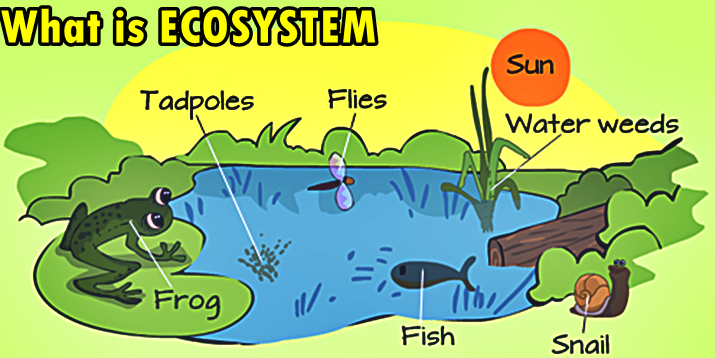Back to: BIOLOGY SS1
Welcome to class!
In today’s class, we will be talking about the ecosystem. Enjoy the class!
Ecosystem

Meaning of ecosystem
An ecosystem is defined as the interrelationship between the living things and their non-living environment
Components of an ecosystem
In an ecosystem, there are two major parts; the biotic or living and abiotic or non-living part. Then from the functional point of view, we have three kinds as producers, consumers, and decomposers. The producers are always green plants; the consumers are the animals, while the decomposers are the saprophytes.
Under the consumers we have the following:
- Primary consumers, e.g. grasshopper, rat etc.
- Secondary consumers, e.g. cat, lizard etc.
- Tertiary consumer, e.g. hawks, snakes.
- Omnivores, e.g. man, domestic fowl.
Decomposers:
are organisms which feed on the carcasses of dead producers and consumers and in the process bring about the decay of such carcasses. Large decomposers such as insects and earthworms are called macro decomposers, whereas small decomposers, such as certain bacteria and fungi are known as micro decomposers.
Role of decomposers
The role of decomposers is the recycling and conversion of materials of dead organic materials into inorganic materials which are available to the producers in the ecosystem.
Food chain, food webs and trophic levels
As living and non-living things interact, energy is transferred from one level to the other.
Food chain:
A food chain is the transfer of food energy from producers (green plants) to a series of organisms in a habitat. In the arrangement of the food chain, the natural rule is that it must start from a producer or an autotroph. Some examples of the food chain are below:
- Grass → Grasshopper → Lizard → Snake
- Plankton → Tilapia → Watersnake
- Deadwood → Termite → Frog → Hawke
Note: that each level of transfer in the food chain is called a trophic level.
Food web:
simple food chains as shown above rarely exist within a community because consumers don’t depend on only one type of food. Often a particular food item is eaten by more than one consumer. Therefore, a network of interrelated food chains forms what is called a food web.
Trophic levels:
These are stages at which the energy is found as it moves through the various organisms or levels of transfer in the ecosystem.
Food pyramid:
The food pyramid is a representation of a food chain with the food producers from the base and carnivores at the apex.
Pyramid of numbers:
This is the progressive drop in the population at each higher or successive trophic level of the food chain or the relative decrease in the number of organisms in a food chain as one ascends the higher trophic levels.
Pyramid of biomass:
The pyramid of Biomass (or standing crop) indicates, by weight, the total mass of individuals or organisms at each trophic levels.
Pyramid of energy:
This is the progressive drop or decrease in the total available energy at each higher trophic level or the progressive diminution of energy in the feeding chain as one ascends the higher tropic levels.
Nutrient movement
Nutrient movement refers to the chemical energy in the form of carbohydrates, fats, protein, and other nutrients are distributed among producers, consumers and decomposers. It just about how nutrients flow from one energy level to the other in the ecosystem.
In our next class, we will be talking about Energy Transformation in Nature. We hope you enjoyed the class.
Should you have any further question, feel free to ask in the comment section below and trust us to respond as soon as possible.

Lean boilogy
My name is muhammed abubakar ABdurrahman
From taha Islamic centa
very amazing and good